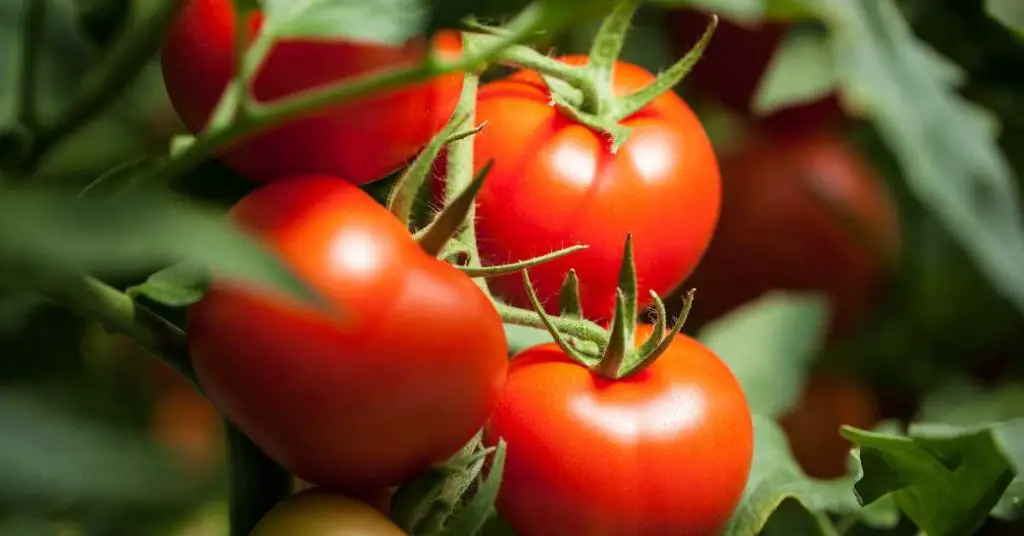Growing tomatoes in 5-gallon buckets is an excellent solution for gardeners who may not have ample ground space but still want to enjoy fresh, homegrown tomatoes.
This method is not only space-efficient but also portable, allowing you to move your plants to optimize sunlight exposure or to protect them during adverse weather conditions.
Whether you’re an apartment dweller with just a balcony or a homeowner with limited garden space, 5-gallon buckets offer a practical way to grow your own tomatoes.
Why You Would Want to Grow Tomatoes in 5 Gallon Buckets?
Growing tomatoes in 5-gallon buckets has several advantages that make it an appealing option for many gardeners:
- Space Efficiency: Buckets can be placed on patios, balconies, or small yards, making the most out of limited space.
- Control Over Soil: Using buckets allows you to create the perfect soil environment for your tomatoes, independent of your ground soil conditions.
- Ease of Maintenance: Managing weeds, pests, and diseases can be easier with container gardening since you can more effectively control the growing conditions.
- Mobility: Buckets can be easily moved to take advantage of the best weather conditions and to protect plants from harsh elements.
- Cost-Effective: Reusing 5-gallon buckets for planting reduces gardening costs and is an excellent way to recycle containers that might otherwise be discarded.
These benefits show why bucket gardening is a popular choice for growing tomatoes, providing flexibility and accessibility for gardeners of all types.

This post may contain affiliate links. Read our full disclosure here.
How To Grow Tomatoes In 5 Gallon Buckets
Choosing the Right Tomato Varieties
When growing tomatoes in 5-gallon buckets, choosing the right varieties is crucial for success. Given the space constraints of containers, some tomato varieties are better suited than others. Here are a few tips on selecting the best types for your bucket garden:
Determinate Varieties
These tomatoes, also known as “bush” tomatoes, are ideal for container growing because they grow to a fixed height and generally do not require extensive staking or caging. They tend to produce a concentrated harvest, which is great if you want a lot of tomatoes at once. Popular determinate varieties include ‘Roma’, ‘Bush Early Girl’, and ‘Patio Princess’.
Compact Indeterminate Varieties
If you prefer a continuous harvest throughout the growing season, consider compact indeterminate varieties. These plants continue to grow and produce fruit until killed by frost but can be managed with proper staking and pruning to remain within the confines of a bucket. Suitable varieties include ‘Cherry Gold’, ‘Balcony’, and ‘Early Cascade’.
Cherry and Grape Tomatoes
These smaller fruit varieties are excellent for 5-gallon buckets due to their lighter weight and prolific nature. Varieties like ‘Sweet 100’, ‘Tiny Tim’, and ‘Yellow Pear’ not only adapt well to container life but also tend to mature quickly.
When selecting tomato varieties, consider your climate, the length of your growing season, and your culinary preferences. Additionally, look for disease-resistant varieties, as containers can sometimes increase the risk of soil-borne diseases due to limited soil volume and reduced airflow compared to in-ground plants. By choosing the right variety, you’ll ensure a more productive and manageable tomato bucket garden.

Preparing Your Buckets
To get started, you’ll need a few 5-gallon buckets, each with several drainage holes drilled at the bottom. Drainage is crucial to prevent water logging and ensure healthy root development. Here’s how to prepare your buckets:
- Choose the Right Buckets: Ensure they are clean and have not previously held toxic materials.
- Drill Drainage Holes: Create multiple holes in the bottom to facilitate adequate drainage.
- Select the Right Soil: Fill the buckets with high-quality potting mix suited for vegetable gardening. Avoid using garden soil, as it can be too heavy and may contain pathogens.
Planting Your Tomatoes
Tomatoes thrive when planted properly in their containers. Here’s how to plant them in your 5-gallon buckets:
- Seedlings vs. Seeds: You can start with seeds indoors and transplant seedlings, or buy young plants from a nursery.
- Planting Depth: Plant tomatoes deeper than they come in the pot. Bury up to two-thirds of the stem, as tomatoes can develop roots all along the buried stem, leading to stronger support and a healthier root system.
- Spacing: Only one tomato plant per bucket to ensure enough space for growth and air circulation.
With your buckets prepared and your tomatoes planted, you’re well on your way to enjoying a bountiful harvest. The next sections will cover the ongoing care, pest management, and harvesting techniques to help you get the most out of your bucket-grown tomatoes.
What Is The Best Way to Stake or Trellis Tomato Plants in 5 Gallon Buckets?
Providing proper support is essential when growing tomatoes in 5-gallon buckets, as it helps manage the plant’s growth, improves air circulation, and makes harvesting easier. Here are effective methods for staking or trellising your container-grown tomatoes:
Staking
- Single Stake: Use a single, sturdy stake, such as a bamboo rod or a wooden dowel, at least 5-6 feet tall. Insert the stake about 2-3 inches from the plant base to avoid damaging the roots. As the tomato grows, tie it to the stake at intervals with soft garden ties or old t-shirt strips, which won’t damage the stems. This method is simple and effective, especially for determinate varieties that don’t grow excessively tall.
Trellising
- Cage: Tomato cages are one of the most popular support methods and can be very effective for bucket-grown tomatoes. Choose a cage that can fit within the bucket without tipping it over. Place the cage around the plant at the time of planting to minimize disturbance later. The cage allows the plant to grow naturally while providing ample support for the branches, making it ideal for both determinate and indeterminate varieties.
- Florida Weave: This method involves using stakes placed on either side of the tomato row (or in this case, around your buckets if you have multiple) and running twine or string in a weaving pattern around the stakes and plants. It’s particularly good for indeterminate varieties as it provides robust lateral support for the growing stems and can easily be adjusted as the plants grow.
Vertical String Method
- String Support: Install a strong overhead structure, such as a horizontal bar above the tomato buckets. Tie a length of strong garden twine or a thin rope to the bar directly above the plant, and tie the other end loosely around the base of the tomato stem, just above the soil. As the plant grows, twist or tie the stem around the string. This method is very space-efficient and works exceptionally well for tall, indeterminate varieties, keeping the plants vertical and the fruit off the ground.
When setting up any support system, consider the adult size of the tomato variety and the potential weight of the fruit load. Ensure all structures are secure and can withstand wind and the weight of the plant at full maturity. Proper support not only helps maintain plant health and fruit quality but also makes maintenance and harvesting easier.

Caring for Your Tomato Plants
Once your tomatoes are happily planted in their 5-gallon buckets, ongoing care is essential to ensure healthy growth and a fruitful harvest. Here are the key areas of focus:
Watering
Tomato plants in containers require consistent moisture to thrive. Check the soil daily; it should be moist but not waterlogged. Water deeply until you see water exit through the drainage holes, ensuring the entire root zone is hydrated. During hot weather, you may need to water once or even twice a day to keep the soil from drying out.
Fertilizing
Tomatoes are heavy feeders and will benefit from regular fertilization. Two weeks after planting, begin feeding with a balanced, water-soluble fertilizer every two weeks. Once the plants start to set fruit, switch to a fertilizer higher in potassium to promote fruit development. Be careful not to over-fertilize, as this can lead to lush foliage at the expense of fruit production.
Sunlight
Tomatoes need plenty of sunlight to grow well—aim for at least 6 to 8 hours of direct sunlight each day. If your garden area receives less light, consider placing your buckets on a movable platform or adding wheels to them. This way, you can easily move your plants around to catch the maximum amount of sunlight throughout the day.
By ensuring adequate water, nutrients, and sunlight you’re setting the stage for strong growth and a bountiful tomato harvest. Regular care is the key to success when growing tomatoes in containers.
Managing Pests and Diseases
Tomato plants, whether grown in gardens or containers, can be susceptible to a variety of pests and diseases. Effective management is crucial to keep your plants healthy and productive. Here are some common issues and solutions for tomatoes grown in 5-gallon buckets:
Pests
- Aphids: These small, sap-sucking insects can cause the leaves to curl and stunt growth. They can be managed by spraying the plants with water to knock them off or using insecticidal soap.
- Tomato Hornworms: These large caterpillars can quickly defoliate a tomato plant. Check your plants regularly and remove hornworms by hand.
- Spider Mites: These tiny pests can be detected by the fine webbing they leave on the undersides of leaves. Increase humidity around your plants with regular misting, or use neem oil to control infestations.
Diseases
- Blight: Both early and late blight can affect tomatoes, showing up as spots on leaves and fruit. To prevent blight, avoid overhead watering, which can spread spores. Remove and dispose of any affected leaves, and consider using fungicidal sprays if the problem persists.
- Root Rot: Overwatering can lead to root rot, particularly in poorly draining soil. Ensure your buckets have adequate drainage and allow the top inch of soil to dry out between waterings.
- Powdery Mildew: This fungal disease appears as a white powdery coating on leaves. It thrives in humid conditions with poor air circulation. Improve air circulation around your plants and consider using a fungicide designed for mildew control.
What Is Blossom End Rot?
Blossom end rot is a common issue in tomato plants where the end of the tomato opposite the stem turns black and begins to rot. This condition typically occurs before the tomato starts to ripen.
Although people commonly think it is a calcium deficiency in the plant, the real reason is irregular watering practices. These inconsistent watering habits can prevent the plant from adequately absorbing calcium from the soil, even if there’s sufficient calcium present.
To prevent blossom end rot, it’s crucial to maintain regular and deep watering routines. Aim to water your tomatoes once or twice a week, depending on weather conditions, but make sure to water deeply each time.
This helps to thoroughly soak the soil, ensuring that the roots can absorb the necessary nutrients, including calcium, effectively. Consistent soil moisture helps to stabilize the uptake of nutrients and can significantly reduce the occurrence of blossom end rot.
By staying vigilant and taking preventive measures, you can protect your tomatoes from the most common threats. Early detection and appropriate treatments can save your plants and ensure a healthy harvest from your 5-gallon buckets.
Harvesting Your Tomatoes
Harvesting tomatoes at the right time is key to enjoying their best flavor and texture. Here’s how to know when your tomatoes are ripe and ready to pick, along with tips for harvesting:
Signs of Ripeness
- Color: Most tomato varieties reach a uniform color when ripe, whether red, yellow, orange, or even purple. The tomato should have an even coloration throughout.
- Firmness: Ripe tomatoes will have a slight give when gently squeezed. If they are too soft, they may be overripe; if very firm, they may need more time on the vine.
- Size: While size can vary greatly among different tomato varieties, a tomato is likely ripe when it has grown to its full size for that particular variety.
Harvesting Tips
- Use Scissors or Pruners: Cut the tomato from the vine with a pair of garden scissors or pruners rather than pulling it. This helps prevent damage to both the fruit and the plant.
- Regular Checks: Check your tomato plants every few days. Tomatoes can ripen quickly, especially in hot weather, so frequent checks will help you harvest at the peak of ripeness.
- Handle with Care: Tomatoes bruise easily. Handle them gently when picking and transporting them to avoid damage.
Post-Harvest
- If you need to store tomatoes, keep them at room temperature for the best flavor. Refrigeration can cause tomatoes to lose their flavor and become mushy.
- If you have an abundance of tomatoes, consider canning, drying, or freezing them to preserve your harvest.
Harvesting your tomatoes properly ensures that you can fully enjoy the fruits of your labor. With these tips, you can pick your tomatoes at their peak, providing delicious, home-grown tomatoes for your meals.
FAQ Section
How Many Tomato Plants Can I Grow in One 5-Gallon Bucket?
It’s best to grow only one tomato plant per 5-gallon bucket. This ensures that the plant has enough space for its roots to spread out and for air to circulate around the foliage, which helps prevent diseases.
Growing more than one plant in a single bucket can lead to competition for nutrients and water, potentially stunting the growth of the plants and reducing your yield.
What Is the Best Tomato Variety for Container Growing?
For container growing, especially in 5-gallon buckets, determinate tomato varieties, also known as “bush” tomatoes, are typically the best choice because they grow to a compact size and have a more defined growing period.
Varieties like ‘Patio Princess’, ‘Bush Early Girl’, and ‘Balcony’ are great choices. Some smaller indeterminate varieties, such as ‘Cherry Tomatoes’ or ‘Grape Tomatoes’, can also perform well in containers if provided with adequate support.
How Often Should I Water My Tomato Plants in 5-Gallon Buckets?
Tomato plants in 5-gallon buckets generally need to be watered daily during hot weather, as the soil in containers tends to dry out quickly. However, the frequency of watering can vary based on temperature, humidity, and the stage of plant growth.
Always check the top inch of soil; if it feels dry to the touch, it’s time to water. During cooler weather, you may need to water less frequently. Ensure the water is reaching the deeper roots by allowing it to soak thoroughly with each watering.
Can I Reuse the Soil in My Buckets for Growing Tomatoes Next Season?
It’s not recommended to reuse soil for growing tomatoes consecutively in the same containers due to the risk of soil-borne diseases and nutrient depletion. If you want to reuse the soil, it should be refreshed with new compost or mixed with new potting soil to replenish nutrients.
Additionally, consider rotating different crops that are less demanding than tomatoes to help prevent disease buildup and maintain soil health.
What Are Some Common Signs of Nutrient Deficiency in Container-Grown Tomatoes?
Common signs of nutrient deficiency in tomatoes include:
- Nitrogen deficiency: Older leaves turn yellow or pale green.
- Phosphorus deficiency: Leaves may show a purplish tint; slow growth and smaller fruits.
- Potassium deficiency: Leaves develop yellow edges and brown scorching, and fruits can be small and poorly colored.
- Calcium deficiency: Blossom end rot, where the end of the fruit opposite the stem becomes dark and sunken. Regularly applying a balanced, water-soluble fertilizer and ensuring proper pH levels can help prevent these deficiencies.
Conclusion
Growing tomatoes in buckets is not only a practical gardening solution but also an enjoyable hobby that can yield delicious results. Experiment with different tomato varieties and growing techniques to find what works best for you and your space.
Whether on a patio, balcony, or in a small backyard, bucket gardening allows you to enjoy the pleasures and rewards of growing your own food.
Remember, each growing season offers new opportunities to learn and improve.
Thank you for following along with this guide. Enjoy your gardening adventures and the tasty tomatoes that come from your effort and care!





